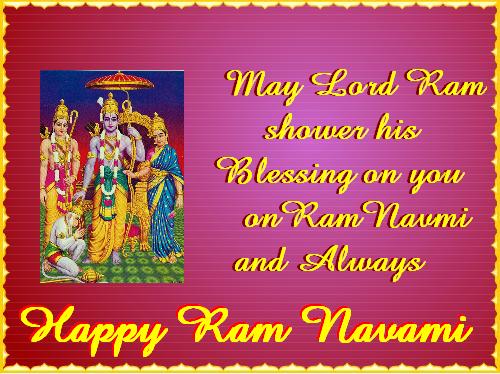Happy Sri Ram Navami
Ram Navami (Devanāgarī: राम नवमी) also known as Sri Rama Navami (IAST SriRām-navamī) is a Hindu festival, celebrating the birth of Lord Rama to King Dasharatha and Queen Kausalya of Ayodhya. Ram is the 7th incarnation of the Dashavatara of Vishnu. Years later Lord Rama was married to Sita on the Vivaha Panchami. The sacred marriage of Devi Sita with Lord Rama was held on Margashirsha Shukla Panchami as per Valmiki Ramayana (This occasion is known as Seetha kalyanam). The SreeRama Navami festival falls in the Shukla Paksha on the Navami, the ninth day of the month of Chaitra in the Hindu calendar. Thus it is also known as Chaitra Masa Suklapaksha Navami, and marks the end of the nine-day Chaitra-Navratri celebrations.
At some places the festival lasts the whole nine days of the Navratras, thus the period is called 'Sri Rama Navratra'. It is marked by continuous recitals, Akhand Paath, mostly of the Ramacharitamanas, organized several days in advance to culminate on this day, with elaborate bhajan, kirtan and distribution of prasad after the puja and aarti. Images of infant form of Sri Rama are placed on cradles and rocked by devotees. Since Rama is the 7th incarnation of Vishnu having born at noon, temples and family shrines are elaborately decorated and traditional prayers are chanted together by the family in the morning. Also, at temples special havans are organized, along with Vedic chanting of Vedic mantras and offerings of fruits and flowers. Many followers mark this day by Vrata (fasting) through the day followed by feasting in the evening, or at the culmination of celebrations. In South India,in Bhadrachalam the day is also celebrated as the wedding anniversary of Sri Rama and his consort Sita. Sitarama Kalyanam, the ceremonial wedding ceremony of the celestial couple is held at temples throughout the south region, with great fanfare and accompanied by group chanting of name of Rama, (Rama Nama Smaranam). Whereas the marriage is celebrated in Mithila and Ayodhya during another day on Vivaha Panchami as per Valmiki Ramayana.
The important celebrations on this day take place at Ayodhya (Uttar Pradesh), Bhadrachalam (Andhra Pradesh) and Rameswaram (Tamil Nadu), thronged by thousands of devotees. Rathayatras, the chariot processions, also known as Shobha yatras of Rama, Sita, Lakshmana and Hanuman, are taken out at several places, including Ayodhya where thousands of people take a dip in the sacred river Sarayu.
At some places the festival lasts the whole nine days of the Navratras, thus the period is called 'Sri Rama Navratra'. It is marked by continuous recitals, Akhand Paath, mostly of the Ramacharitamanas, organized several days in advance to culminate on this day, with elaborate bhajan, kirtan and distribution of prasad after the puja and aarti. Images of infant form of Sri Rama are placed on cradles and rocked by devotees. Since Rama is the 7th incarnation of Vishnu having born at noon, temples and family shrines are elaborately decorated and traditional prayers are chanted together by the family in the morning. Also, at temples special havans are organized, along with Vedic chanting of Vedic mantras and offerings of fruits and flowers. Many followers mark this day by Vrata (fasting) through the day followed by feasting in the evening, or at the culmination of celebrations. In South India,in Bhadrachalam the day is also celebrated as the wedding anniversary of Sri Rama and his consort Sita. Sitarama Kalyanam, the ceremonial wedding ceremony of the celestial couple is held at temples throughout the south region, with great fanfare and accompanied by group chanting of name of Rama, (Rama Nama Smaranam). Whereas the marriage is celebrated in Mithila and Ayodhya during another day on Vivaha Panchami as per Valmiki Ramayana.
The important celebrations on this day take place at Ayodhya (Uttar Pradesh), Bhadrachalam (Andhra Pradesh) and Rameswaram (Tamil Nadu), thronged by thousands of devotees. Rathayatras, the chariot processions, also known as Shobha yatras of Rama, Sita, Lakshmana and Hanuman, are taken out at several places, including Ayodhya where thousands of people take a dip in the sacred river Sarayu.



